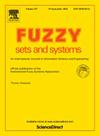非对称区间数:不确定性建模的新方法
IF 3.2
1区 数学
Q2 COMPUTER SCIENCE, THEORY & METHODS
引用次数: 0
摘要
本文介绍了非对称区间数 (AIN),这是一种新型区间数,它结合了经典区间数的直接识别特性和模糊集的先进不确定性建模能力,同时又保持了简洁性。AIN 包含区间内的期望值,与经典区间数相比,能更准确地表示数据的不确定性。我们定义了 AIN 的基本算术运算,讨论了它们的特性,并提供了证明。此外,我们还提出了基本二元和一元运算的对称性和不对称性定理,从而加强了 AIN 的数学框架。几个示例展示了 AIN 的实际应用。尽管仍存在一些挑战,如探索不同分布的性能和减少高估,但 AINs 是区间运算中一个很有前途的进步。本研究强调了 AINs 的实践和理论意义,为进一步研究 AINs 并将其应用于各种科学和工业领域铺平了道路。本文章由计算机程序翻译,如有差异,请以英文原文为准。
Asymmetric interval numbers: A new approach to modeling uncertainty
This paper introduces Asymmetric Interval Numbers , a novel type of interval numbers that combines the straightforward identification characteristic of classical interval numbers with the advanced capability for modeling uncertainty found in fuzzy sets, all while maintaining simplicity. incorporate the expected value within the interval, providing a more accurate representation of the uncertainty of the data compared to the classical interval numbers. We define basic arithmetic operations for , discuss their properties, and provide proofs. Additionally, we present theorems on symmetry and asymmetry for fundamental binary and unary operations, enhancing the mathematical framework for . Several illustrative examples demonstrate the practical application of . Although challenges remain, such as exploring performance with different distributions and reducing overestimation, present a promising advancement in interval arithmetic. This study underscores the practical and theoretical implications of , paving the way for further research and application in diverse scientific and industrial contexts.
求助全文
通过发布文献求助,成功后即可免费获取论文全文。
去求助
来源期刊

Fuzzy Sets and Systems
数学-计算机:理论方法
CiteScore
6.50
自引率
17.90%
发文量
321
审稿时长
6.1 months
期刊介绍:
Since its launching in 1978, the journal Fuzzy Sets and Systems has been devoted to the international advancement of the theory and application of fuzzy sets and systems. The theory of fuzzy sets now encompasses a well organized corpus of basic notions including (and not restricted to) aggregation operations, a generalized theory of relations, specific measures of information content, a calculus of fuzzy numbers. Fuzzy sets are also the cornerstone of a non-additive uncertainty theory, namely possibility theory, and of a versatile tool for both linguistic and numerical modeling: fuzzy rule-based systems. Numerous works now combine fuzzy concepts with other scientific disciplines as well as modern technologies.
In mathematics fuzzy sets have triggered new research topics in connection with category theory, topology, algebra, analysis. Fuzzy sets are also part of a recent trend in the study of generalized measures and integrals, and are combined with statistical methods. Furthermore, fuzzy sets have strong logical underpinnings in the tradition of many-valued logics.
 求助内容:
求助内容: 应助结果提醒方式:
应助结果提醒方式:


